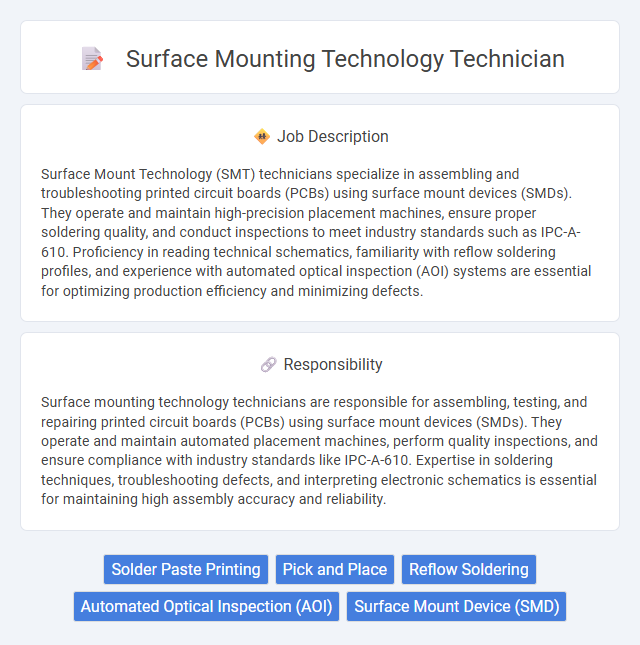
Surface Mount Technology (SMT) technicians specialize in assembling and troubleshooting printed circuit boards (PCBs) using surface mount devices (SMDs). They operate and maintain high-precision placement machines, ensure proper soldering quality, and conduct inspections to meet industry standards such as IPC-A-610. Proficiency in reading technical schematics, familiarity with reflow soldering profiles, and experience with automated optical inspection (AOI) systems are essential for optimizing production efficiency and minimizing defects.
Individuals with strong attention to detail and good hand-eye coordination are likely to be well-suited for a Surface Mounting Technology technician role. Those who handle repetitive tasks patiently and can work in environments with moderate noise and chemicals may find it easier to adapt. People without steady hands or who struggle in high-precision settings might face challenges in this job.
Qualification
Surface mounting technology technicians require a solid foundation in electronics, often demonstrated through an associate degree or technical certification in electronic engineering or a related field. Proficiency in operating pick-and-place machines, soldering, reflow ovens, and inspection equipment is essential, complemented by knowledge of surface mount device (SMD) components and PCB layouts. Strong attention to detail, troubleshooting skills, and familiarity with industry standards such as IPC-A-610 and J-STD-001 significantly enhance job performance and employability.
Responsibility
Surface mounting technology technicians are responsible for assembling, testing, and repairing printed circuit boards (PCBs) using surface mount devices (SMDs). They operate and maintain automated placement machines, perform quality inspections, and ensure compliance with industry standards like IPC-A-610. Expertise in soldering techniques, troubleshooting defects, and interpreting electronic schematics is essential for maintaining high assembly accuracy and reliability.
Benefit
Surface mounting technology technicians likely experience enhanced career prospects due to growing demand in electronics manufacturing. They may benefit from working with advanced, cutting-edge machinery that boosts technical skills and job competency. Job stability and competitive salaries could also be probable advantages in this evolving industry.
Challenge
Surface mounting technology (SMT) technicians likely face challenges related to the precision required in placing tiny electronic components on circuit boards, demanding steady hands and keen attention to detail. The probability of encountering frequent equipment malfunctions or calibration issues may require quick troubleshooting skills and adaptability. Managing the balance between speed and accuracy is possibly a constant pressure in fast-paced manufacturing environments.
Career Advancement
A Surface Mounting Technology (SMT) technician advances by mastering advanced PCB assembly techniques, equipment calibration, and quality control processes critical in electronics manufacturing. Proficiency in programming and maintaining SMT machines, coupled with skills in solder paste inspection and reflow profiling, creates pathways to supervisory or engineering roles. Continuous training in new SMT technologies and certifications accelerates career growth and opens opportunities in production management or process engineering.
Key Terms
Solder Paste Printing
Surface Mount Technology (SMT) technicians specializing in solder paste printing play a critical role in the manufacturing of printed circuit boards (PCBs) by accurately applying solder paste to PCB pads. Mastery of stencil alignment, paste viscosity control, and printing parameters ensures optimal solder joint reliability and reduces defects such as solder bridging or insufficient soldering. Proficiency with solder paste inspection systems and knowledge of reflow profiles directly impact the efficiency and quality of SMT assembly lines.
Pick and Place
Surface mounting technology technicians specialize in the precise operation and maintenance of pick and place machines, vital for automated PCB assembly. These technicians ensure accurate component placement by calibrating feeders, nozzles, and vision systems, significantly reducing errors in high-volume manufacturing. Proficiency in programming and troubleshooting pick and place equipment enhances production efficiency and minimizes downtime in electronics manufacturing environments.
Reflow Soldering
Surface mounting technology technicians specialize in reflow soldering, a critical process for attaching surface mount components to printed circuit boards (PCBs). They ensure precise temperature profiles to melt solder paste uniformly, preventing defects like tombstoning or insufficient wetting. Expertise in monitoring reflow oven parameters and inspecting solder joints guarantees optimal electrical connections and overall product reliability.
Automated Optical Inspection (AOI)
A Surface Mounting Technology Technician specializing in Automated Optical Inspection (AOI) ensures the quality and accuracy of printed circuit boards by using advanced imaging systems to detect defects such as soldering issues, component misplacements, and missing parts. Proficiency in interpreting AOI software results and adjusting machinery settings is crucial for minimizing production errors and improving yield rates. Expertise in AOI enables technicians to optimize manufacturing processes, maintain rigorous quality control standards, and reduce manual inspection time.
Surface Mount Device (SMD)
Surface Mount Device (SMD) technicians specialize in assembling, soldering, and inspecting electronic components directly onto printed circuit boards (PCBs) using Surface Mount Technology (SMT). They utilize precision equipment such as pick-and-place machines and reflow soldering ovens to ensure accurate placement and strong electrical connections of SMD components. Proficiency in reading circuit diagrams, understanding SMD specifications, and conducting quality control tests is essential for maintaining high production standards in electronics manufacturing.
 kuljobs.com
kuljobs.com